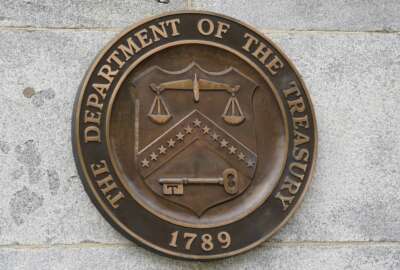Justice Department expands its procurement fraud strike force
Sometimes federal procurements don't go according to the rules. Sometimes its worse, when bribes and kickbacks come into play.
Sometimes federal procurements don’t go according to the rules. Sometimes its worse, when bribes and kickbacks come into play. That’s what the Justice Department’s Procurement Collusion Strike Force tries to discover and prosecute. Now the strike force is expanding, with four new members. For details, the Federal Drive with Tom Temin spoke with the Dan Glad, the director of the Strike Force.
Interview Transcript:
Tom Temin And just briefly review the task, the strike force, what it does and what its scope is and where it fits in the hierarchy of oversight here in the government.
Dan Glad Sure. The term collusion strike force, which is a mouthful. So, I’ll call it the PCSF or the strike force. That is the Department of Justice’s coordinated national and inter-agency response to anti-trust crimes and other related fraud schemes that impact government procurement, grant, and program funding at all levels of government, federal, state, and local. And we’ve been around since late 2019. And our mission is really two pronged. One is to enhance deterrence, trying to stop these schemes before they happen. And we do that through education, outreach, and training to both federal agents who investigate these crimes and procurement officers at all levels who are in the position to spot them. And then when deterrence fails and deterrence fails, men are no angels. We look to amplify the detection, investigation, and prosecution of these schemes. I think you asked, Tom, sort of sort of like what we actually do. I’ll tell you what I call our lane. And it’s really we use all the tools in the statutory toolbox, all the parts of the Criminal Code to go after any criminal conduct that distorts, perverts, subverts the competitive procurement process. When the government is going out into the market to buy stuff.
Tom Temin And how do you find out about the fallen angels? Is it mostly whistleblowers?
Dan Glad Whistleblowers are certainly part of the mix. It’s really a combination. We certainly will have whistleblowers who come in and who spot something. The Antitrust Division, which is the part of the Department of Justice I come from, has a long-standing policy of its leniency policy, which is essentially become a cooperator. Tell us about the crimes that you did. And if you do fully cooperate, you’ll get a benefit. The public, we rely on the public to send us tips and leads, and we have a public facing website where members of the public can submit information. Our federal agents and investigators are well positioned to using either confidential sources or just the things they see to refer these matters to us. And then finally, I think I would be remiss if I didn’t mention the people who are really there the procurement officers, the contracting officers, the people in government whose day-to-day job is buying stuff. They are able to spot the indicators, the red flags of these collusive schemes and report them. They often know something’s wrong, even if they can’t put a term on it. And so that’s part of our outreach mission. And since we were founded, we’ve reached more than 31,000 government employees as part of this outreach. That’s 31,000 sets of eyes.
Tom Temin And since 2019, how busy has the strike force been? How many cases have you actually come together and gone after?
Dan Glad We’ve been busy. Since 2019, we’ve opened more than 100 criminal investigations. We have prosecuted to conviction. So, either at trial or through a guilty plea, more than 50 individuals and companies and of our public matter, some cases that are filed. This touches on more than $500 million of government spending. And I will say, I think it’s just the tip of the iceberg.
Tom Temin Well, that was my question. And by the way, we’re speaking with Dan Glad he is director of the Procurement Collusion Strike Force at the Justice Department and the Antitrust Division. I mean, the federal procurement system in the United States is in many ways the gold standard for the world. And most people that participate believe that it’s fundamentally honest. It’s not like India or Russia where bribery and corruption is the norm. Are we still in that place? And these are still exceptions because you say it occurs a lot. Collusion and so forth.
Dan Glad They are exceptions. Federal government procurement is fundamentally sound. The majority of federal government procurement is not a set and attacked by bid rigging, price fixing and fraud schemes. But I think about it in the way it’s the law of large numbers. There’s so much federal procurement that even a fractional loss is substantial. Tom, there’s one study I’m aware of from an international NGO called the organization for Economic Co-operation and Development, or the OECD. And what the OECD tried to do is assess how much money is lost from bid rigging, price fixing and other collusive schemes at the outset from government spending. They looked at all governments around the world, and their assessment is that it’s 20%, that there was a 20% collusion tax imposed by criminal conspiracies on government spending around the world, and the US is probably right there in the middle of that 20% number as a whole. I would say there are parts of the United States that may be higher. Tom, I mentioned before we started talking today that my hometown of Chicago and I worked as the assistant inspector general for the city of Chicago before coming to the Department of Justice. And I can say based on my experience, I think my hometown, though I love it, is likely overperforming that 20% number. There’s another way to think about it. There’s this great quote from a recent 11th Circuit case where the judge opened the opinion by saying, and this is a quote like bears to honey. White collar criminals are drawn to billion-dollar government programs. And that’s true. And I’ll tell you the last way I think about, and I’ve mentioned this because it’s very recent, the GAO, the Government Accountability Office just put out a report where they were trying to estimate they were trying to answer this question. Tom, what is the cost of fraud across the government? And they came up with a numerical figure that’s quite broad, 233 billion to 521 billion every year. And what really stuck with me was the way they contextualized it. They said that if fraud were a government agency, it would be the sixth largest government agency in the United States if there were a U.S. Department of Fraud.
Tom Temin All right. Well, we could probably discuss that philosophically for hours. Let’s get to the operation of the task force. You’ve added new members. Who are they? And what does it mean when a new members added what’s incumbent upon them?
Dan Glad Maybe I took a step back, Tom, and explain sort of our structure. Our strike force includes federal prosecutors. So that’s folks from the Antitrust Division, and we’re now up to 25 US attorney’s offices. So those are the federal prosecutors who sit in cities and districts around the country. We have 12 national law enforcement partners. So, it’s 11 offices of inspector general at the federal level and the FBI. And so, we work together on that two-prong mission set. I’m really happy that we recently welcomed another office of inspector general, the US Department of Commerce, that is now one of our national partners, as well as three new US attorney’s offices to our collective effort. And that’s the District of New Jersey, the District of Alaska, and the Eastern District of Louisiana, which is headquartered in New Orleans. And they will be joining our existing collective effort and also doing environmental scans and being on the lookout and thinking strategically about what’s happening in the commerce world and also in those geographies and on commerce. The U.S. Department of Commerce is embarking on some pretty significant spending. Its second largest spending program in the history of the department is the Bipartisan Infrastructure Law, its number one spot program of all time since its existence is the Chips act. And those are two very recent spending bills.
Tom Temin And by the way, do you also look at state and local level corruption when that happens? Because sometimes the states and the cities don’t have the resources the federal government has.
Dan Glad Absolutely. Some of the core antitrust offenses bid rigging, price fixing, market allocation, criminal monopolization, those are federal offenses wherever they occur at any point in the market, private and public and within the public, which is really where I focus my efforts and my thinking local, state and federal. And we do rely on and work with our partners at that local and state level to uncover, investigate and prosecute crimes that are going after their funding. Relatedly, so much of the funding that comes in to the local and state governments is in whole or in part coming from the federal government. So, the federal government has a very vested interest in making sure that the programs have integrity.
Tom Temin Sure. And just any recent cases that come to mind that kind of stand out for you?
Dan Glad Yeah. Tom, very recently in the month of May, we had a guilty plea in our Idaho fire investigation. There. We indicted two executives with fraud and rigging bids that were submitted to the US Forest service for contracts to provide critical supplies used to fight forest fires. And this was after an investigation that involved court authorized wiretaps. And earlier this month, one of those executives pleaded guilty. Now, what happened here, Thomas? For at least eight years, two executives who were supposed to be competing were not. They conspired to rig bids. They conspired to allocate territories. And this is offering a crucial service that helps U.S. government fight fires in the Rocky Mountain region. And over time, the conspiracy evolved. And they inspired these competitors or anything but competitors. These executives conspired to monopolize the market and they conspired to push other people out. And I’ll say Tom, the evidence here was just really compelling. The executives would text each other talking about how they were going to, quote, squeeze, drown, punch, or lowball their competitors. The wiretap evidence where our federal agents were able to listen in real time due to a court order to the conspirators talking. We were able to hear the executives, and this is all, as alleged in the indictment, conspire about their upcoming bids, about what they would tell the FBI agent. So, the FBI came knocking and how they would hide their conduct. And this really gets to sort of why we do what we do. The U.S. Forest Service relies on a fair bidding process to secure the best deal at the best price for taxpayers. And when people like these executives as allegedly indictment, collude rather than compete, they wronged the public. And more than that time, they are wrong honest competitors who play by the rules. And are doing things fair and square.
Tom Temin Finally, you mentioned that contracting officers, COs 1102s, and people in that function in the federal government are kind of eyes and ears on this. What would you say are the top three signals that a CO should be watching for? That might indicate something bad going on with a contract or an acquisition.
Dan Glad I think the first is any indicators in the contract, in the bid documents, in the contract and documents, any tells that competitors are anything but that two or more bidders are working together. And sometimes that can be the sloppiness that can result. Where you can see a classic example is the same typo. That is, it’s not proof positive, but it’s a lawyer would say it’s probative of a collusive conspiracy. The other thing I always tell contracting officers, and it sort of goes back to my thought that humans are pattern recognition machines. We can recognize patterns even if we can’t articulate it. If a contracting officer has this sense that they know who’s going to win before they, in the old days, open the envelopes with the bid. But today sort of go into the procurement platform to open the bids. I would ask a contracting officer sort of pause. And as they said in Star Wars, search your feelings, figure out what’s going on, why you have this inclination that someone’s going to win. Again, not proof positive, but these schemes are iterative. They are pattern. They happen over time. There’s no such thing Tom as a bid rigging Crime of passion. You have. Over time, when you are procurement professional, you’re invested, and you will have been able to spot that pattern. And the third thing is sort of look in the pricing, look at the information you have. If pricing is all going up lockstep that’s a red flag not proof positive but it’s a red flag. There may be an innocent explanation for it. If pricing is very, very close or it’s off by round numbers or round percentages, that can be an indicator of a collusive scheme bid rigging, price fixing, or some other kind of fraud.
Copyright © 2025 Federal News Network. All rights reserved. This website is not intended for users located within the European Economic Area.
Tom Temin is host of the Federal Drive and has been providing insight on federal technology and management issues for more than 30 years.
Follow @tteminWFED






